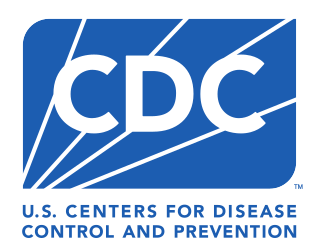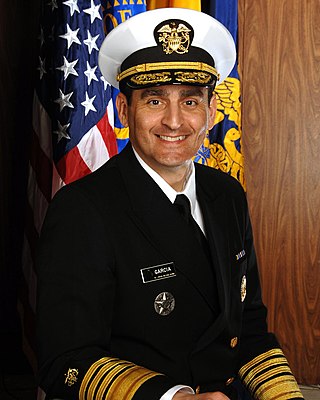Related Research Articles

The Centers for Disease Control and Prevention (CDC) is the national public health agency of the United States. It is a United States federal agency under the Department of Health and Human Services, and is headquartered in Atlanta, Georgia.

The AIDS epidemic, caused by HIV, found its way to the United States between the 1970s and 1980s, but was first noticed after doctors discovered clusters of Kaposi's sarcoma and pneumocystis pneumonia in homosexual men in Los Angeles, New York City, and San Francisco in 1981. Treatment of HIV/AIDS is primarily via the use of multiple antiretroviral drugs, and education programs to help people avoid infection.

World AIDS Day, designated on 1 December every year since 1988, is an international day dedicated to raising awareness of the AIDS pandemic caused by the spread of HIV infection and mourning those who have died of the disease. The acquired immunodeficiency syndrome (AIDS) is a life-threatening condition caused by the human immunodeficiency virus (HIV). The HIV virus attacks the immune system of the patient and reduces its resistance to other diseases. Government and health officials, non-governmental organizations, and individuals around the world observe the day, often with education on AIDS prevention and control.
Post-exposure prophylaxis, also known as post-exposure prevention (PEP), is any preventive medical treatment started after exposure to a pathogen in order to prevent the infection from occurring.

The United States President's Emergency Plan For AIDS Relief (PEPFAR) is a United States governmental initiative to address the global HIV/AIDS epidemic and help save the lives of those suffering from the disease. Launched by U.S. President George W. Bush in 2003, as of May 2020, PEPFAR has provided about $90 billion in cumulative funding for HIV/AIDS treatment, prevention, and research since its inception, making it the largest global health program focused on a single disease in history until the COVID-19 pandemic. PEPFAR is implemented by a combination of U.S. government agencies in over 50 countries and overseen by the Global AIDS Coordinator at the United States Department of State. As of 2023, PEPFAR has saved over 25 million lives, primarily in sub-Saharan Africa.
HIV/AIDS has been a public health concern for Latin America due to a remaining prevalence of the disease. In 2018 an estimated 2.2 million people had HIV in Latin America and the Caribbean, making the HIV prevalence rate approximately 0.4% in Latin America.

The global pandemic of HIV/AIDS began in 1981, and is an ongoing worldwide public health issue. According to the World Health Organization (WHO), by 2023, HIV/AIDS had killed approximately 40.4 million people, and approximately 39 million people were infected with HIV globally. Of these, 29.8 million people (75%) are receiving antiretroviral treatment. There were about 630,000 deaths from HIV/AIDS in 2022. The 2015 Global Burden of Disease Study estimated that the global incidence of HIV infection peaked in 1997 at 3.3 million per year. Global incidence fell rapidly from 1997 to 2005, to about 2.6 million per year. Incidence of HIV has continued to fall, decreasing by 23% from 2010 to 2020, with progress dominated by decreases in Eastern Africa and Southern Africa. As of 2020, there are approximately 1.5 million new infections of HIV per year globally.
The Office of National AIDS Policy, established under President Clinton in 1993, coordinates the continuing domestic efforts to implement the President's National HIV/AIDS Strategy. In addition, the office works to coordinate an increasingly integrated approach to the prevention, care and treatment of HIV/AIDS. As a unit of the Domestic Policy Council, the Office of National AIDS Policy coordinates with other White House offices. It is led by a director, who is appointed by the president.
The very high rate of human immunodeficiency virus infection experienced in Uganda during the 1980s and early 1990s created an urgent need for people to know their HIV status. The only option available to them was offered by the National Blood Transfusion Service, which carries out routine HIV tests on all the blood that is donated for transfusion purposes. The great need for testing and counseling resulted in a group of local non-governmental organizations such as The AIDS Support Organisation, Uganda Red Cross, Nsambya Home Care, the National Blood Bank, the Uganda Virus Research Institute together with the Ministry of Health establishing the AIDS Information Centre in 1990. This organization worked to provide HIV testing and counseling services with the knowledge and consent of the client involved.

Joxel García is a Puerto Rican physician and a former four-star admiral in the U.S. Public Health Service Commissioned Corps. He served as the fourteenth Assistant Secretary for Health (ASH), U.S. Department of Health and Human Services from March 13, 2008, to January 20, 2009. He served as the Director of Health in the District of Columbia. He served as the Executive Director of the MD Anderson Cancer Control and Prevention Platform and Member of the Leadership Team of the MD Anderson Moon Shots program until May 2017 before joining American Express as Vice President and Chief Medical Officer.

A sexually transmitted infection (STI), also referred to as a sexually transmitted disease (STD) and the older term venereal disease (VD), is an infection that is spread by sexual activity, especially vaginal intercourse, anal sex, oral sex, or sometimes manual sex. STIs often do not initially cause symptoms, which results in a risk of transmitting them on to others. The term sexually transmitted infection is generally preferred over sexually transmitted disease or venereal disease, as it includes cases with no symptomatic disease. Symptoms and signs of STIs may include vaginal discharge, penile discharge, ulcers on or around the genitals, and pelvic pain. Some STIs can cause infertility.
HIV/AIDS in Eswatini was first reported in 1986 but has since reached epidemic proportions. As of 2016, Eswatini had the highest prevalence of HIV among adults aged 15 to 49 in the world (27.2%).

Robert Ray Redfield Jr. is an American virologist who served as the Director of the U.S. Centers for Disease Control and Prevention and the Administrator of the Agency for Toxic Substances and Disease Registry from 2018 to 2021.
Launched in October 2008, the Southern AIDS Living Quilt is a website dedicated to promoting awareness of the growing impact of HIV/AIDS on women in the southern United States, particularly women of color.
The HIV Prevention Act of 1997 was proposed U.S. legislation that was not acted on by either house of Congress.
The relationship between religion and HIV/AIDS has been an ongoing one, since the advent of the pandemic. Many faith communities have participated in raising awareness about HIV/AIDS, offering free treatment, as well as promoting HIV/AIDS testing and preventative measures. Christian denominations, such as Lutheranism and Methodism, have advocated for the observance of World AIDS Day to educate their congregations about the disease. Some Churches run voluntary blood testing camps and counselling centers to diagnose and help those affected by HIV/AIDS.
Since reports of emergence and spread of the human immunodeficiency virus (HIV) in the United States between the 1970s and 1980s, the HIV/AIDS epidemic has frequently been linked to gay, bisexual, and other men who have sex with men (MSM) by epidemiologists and medical professionals. It was first noticed after doctors discovered clusters of Kaposi's sarcoma and pneumocystis pneumonia in homosexual men in Los Angeles, New York City, and San Francisco in 1981. The first official report on the virus was published by the Center for Disease Control (CDC) on June 5, 1981, and detailed the cases of five young gay men who were hospitalized with serious infections. A month later, The New York Times reported that 41 homosexuals had been diagnosed with Kaposi's sarcoma, and eight had died less than 24 months after the diagnosis was made.
HIV in pregnancy is the presence of an HIV/AIDS infection in a woman while she is pregnant. There is a risk of HIV transmission from mother to child in three primary situations: pregnancy, childbirth, and while breastfeeding. This topic is important because the risk of viral transmission can be significantly reduced with appropriate medical intervention, and without treatment HIV/AIDS can cause significant illness and death in both the mother and child. This is exemplified by data from The Centers for Disease Control (CDC): In the United States and Puerto Rico between the years of 2014–2017, where prenatal care is generally accessible, there were 10,257 infants in the United States and Puerto Rico who were exposed to a maternal HIV infection in utero who did not become infected and 244 exposed infants who did become infected.
HIV screening in the United States is the use of tests to determine HIV status of individuals, as a part of general public health strategies to reduce the rate of transmission of HIV/AIDS in the United States and to lead to treatment of HIV positive individuals. As a public health measure, widespread testing is advocated by some. Programs such as the National HIV Testing Day on June 27 are used to promote it. The New England Journal of Medicine endorsed widespread testing in 2013. There are special challenges in reaching teenagers. Numerous areas have offered free and rapid HIV testing to the public, including Atlanta, Georgia on World AIDS Day, December 1.
Ready, Set, PrEP is a program of the U.S. Department of Health and Human Services (HHS) that provides free access to the HIV prevention medication PrEP for thousands of qualifying individuals. The program is a key component of Ending the HIV Epidemic: A Plan for America (EHE) initiative to expand access to PrEP and reduce new HIV diagnoses in the U.S.
References
- ↑ "Mike Leavitt, Secretary of Health and Human Services, World AIDS Day 2006 Press Release". Archived from the original on 2010-03-30. Retrieved 2017-09-08.
- ↑ White House World AIDS Day 2006
- ↑ "Juggle Top Government Blog Award to AIDS.gov". Archived from the original on 2010-09-04. Retrieved 2010-10-07.
- ↑ "HIV.gov Mission and Team". U.S. Department of Health & Human Services. Retrieved 20 March 2018.
- ↑ "Department of Health and Human Services "AIDS.gov Goes 2.0" Press Release". Archived from the original on 2008-09-17. Retrieved 2008-09-08.
- ↑ "HHS and Kaiser Family Foundation Team Up to Promote Text Messaging in the Fight Against HIV/AIDS". Archived from the original on 2008-05-14. Retrieved 2008-03-24.
- ↑ "KNOWIT Campaign". Archived from the original on 2008-09-05. Retrieved 2008-09-08.
- ↑ "PRWeek World AIDS Day 2008 Article". Archived from the original on 2012-04-19. Retrieved 2008-12-19.
- ↑ Ogilvy Blog Post: World AIDS Day 2008: AIDS.gov Celebrates Two Years
- ↑ "AIDS.gov World AIDS Day 2008 Page". Archived from the original on 2008-10-25. Retrieved 2008-11-04.
- ↑ "Bloggers Unite". Archived from the original on 2008-12-17. Retrieved 2008-12-19.
- ↑ "Second Life World AIDS Day 2008". Archived from the original on 2009-04-30. Retrieved 2008-12-19.
- ↑ Department of Health and Human Services World AIDS Day 2008 Press Release
- ↑ Facing AIDS 2009 Flickr Blog Post
- ↑ White House National HIV Testing Day 2009 Blog Post
- ↑ "HHS Secretary Sebelius and DC Mayor Fenty HIV Testing PSA". Archived from the original on 2009-07-26. Retrieved 2009-07-24.
- ↑ "AIDS.gov National HIV Testing Day 2009 Page". Archived from the original on 2009-08-25. Retrieved 2009-07-24.